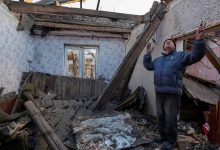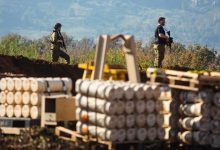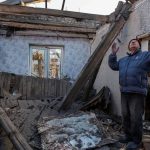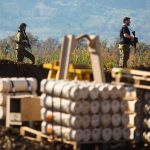It was a phone call from his wife that warned Serhiy that missiles might be headed his way. The security guard had been up since the early morning, woken by the first wave of Russian drones fired towards Kyiv. He had even had time for his first cup of coffee. But nothing prepared him for the three blasts just before eight, the final one the loudest. “We were standing, chatting, all calm,” he recalls, “and then—boom—thrown in the air with everything shaking.”
Several hours after impact, the scene outside his hut remained apocalyptic. Chunks of rocket metal lay twisted on the ground. Bare window panes swung from their frames. A few doors down, smoke bellowed from a red-brick factory, the apparent target of the attack.
Russia’s overnight raids, the biggest in months, were not limited to the capital. Kharkiv, Dnipro, Odessa, Lviv, Zaporizhia and other cities were targeted by a total of at least 110 missiles. It was the most intensive attack Ukraine had seen in such a short space of time, says Yuriy Ihnat, a spokesman for air-force command. (By contrast, about 160 missiles were launched on the first day of the war.) Russia sought to overload Ukrainian air defences, says the spokesman. Although many missiles were shot down, some got through. “The enemy used practically every airborne weapon it has in its arsenal—drones, cruise missiles, and ballistics. We don’t have the resources to intercept everything,” says Mr Ihnat.
At least 26 people were reported killed in the strikes, and more than 100 injured. These numbers are likely to rise. In Kyiv, several people were said to be trapped under the rubble of a collapsed warehouse. In Dnipro, the largest city near the front lines, a maternity ward was damaged and a shopping centre partially destroyed. Russian missiles also hit residential blocks in Odessa and Lviv, to devastating effect.
But a source in Ukraine’s defence industry suggests Russia had predominantly targeted defence facilities. Some were connected to missile and drone production. “The attacks had strategic meaning for the enemy, with the aim of reducing our capacity to strike,” the source says. Both sides are locked in a competition to degrade the enemy. “It’s a battle to see who can destroy more of the enemy’s long-range weapons.”
The long-range aerial battle has taken on additional prominence given the relative stalemate on land. Russia is now making incremental gains along the front line following Ukraine’s underwhelming counter-offensive in the summer. On December 25th Sergei Shoigu, Russia’s defence minister, declared that his forces had taken full control of Mariinka, a suburb of Donetsk, in Ukraine’s east, albeit after nine years of fighting. Fierce battles continue in Avdiivka, 25km to the north-east.
But Ukraine is enjoying more success in the air. On December 22nd its air command reported that it had destroyed at least two Su-34 planes in the Kherson region. Another two were downed two days later. These bombers, which can launch highly destructive glide bombs, had been terrorising Ukrainian troops with impunity.
Then, on December 26th Ukrainian cruise missiles—reportedly British-supplied Storm Shadows—struck the Novocherkassk, a Russian landing ship moored in the Crimean port of Feodosia. Russian sources suggest 77 sailors were on board the stricken ship; 33 are unaccounted for. Retaliation may have been at least part of the motivation for Russia’s attacks on December 29th.
A source in Ukraine’s general staff says attacks on Crimea, a key Russian military hub, will increase over the winter. Russia, for its part, is likely to continue targeting facilities like the red-brick factory. Serhiy, who started work there only a month ago, insists he has no plans to change his place of employment. “Here or there, it makes no difference,” he says. “In Ukraine, we understand no one is protected. We live each day as it comes.”







